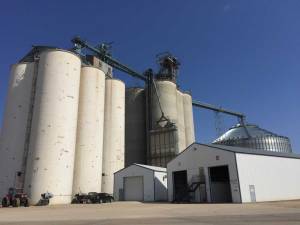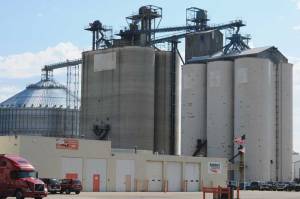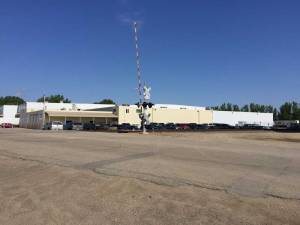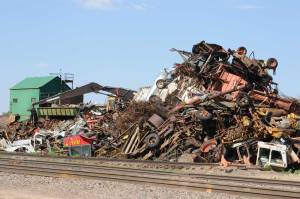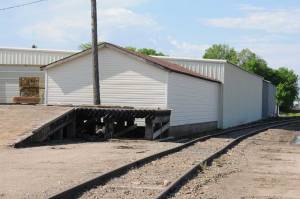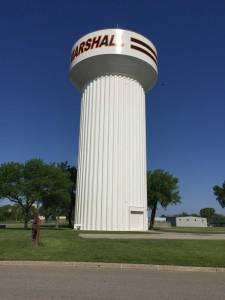I will take you on a tour of the bottom deck of the layout via a series of sequenced images to show you how everything currently looks. The upper deck is still to be constructed although I have all the baseboards and have trialled track in place to test the planning. The image below shows the town and the photo locations but no track diagrams. It is not to scale (although the building dimensions are correct). The main focus is really the relative position of everything in accordance with the sequencing of the photos. Looking at the diagram in image 1, we start the photo sequencing at image 2 and then keep moving to the left (which is east on my layout). You will see in some of the photos the methods used to hold up the second deck. They range from metal supports to wooden cross members on uprights attached to the bottom deck baseboard. Personally, I prefer the solidity of the wooden cross members and their ease of affixing scenic boards. That said, I know there are many great layouts out there using shelf brackets and metal supports. I guess it is up to personal preference.
Image 1: The locations and photo spots on tour
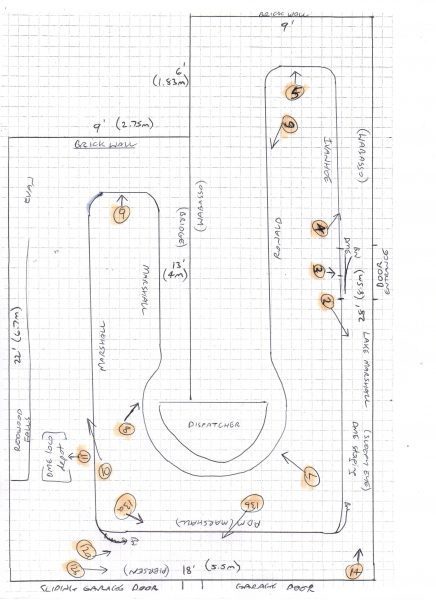 Image 2: For the DME, these are the western staging tracks which for operational purposes are called Brookings, SD. Please remember that my layout has west to the right and east to the left as you stand in front of it. The east staging yards which will be above these tracks are called Sleepy Eye, MN. You can see the supports for the second deck which are not yet permanently affixed.
Image 2: For the DME, these are the western staging tracks which for operational purposes are called Brookings, SD. Please remember that my layout has west to the right and east to the left as you stand in front of it. The east staging yards which will be above these tracks are called Sleepy Eye, MN. You can see the supports for the second deck which are not yet permanently affixed.
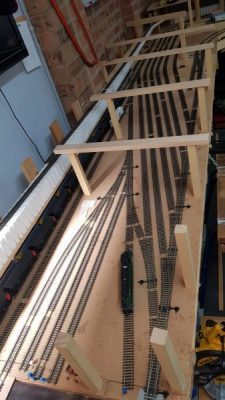 The western staging yard comprises five stub ended sidings and four short loco sidings. The central run-through track allows continuous running on the bottom deck for DME trains and also links another four track staging yard underneath Piersen (behind the garage doors). There are three tracks on the left (the black coal hoppers are in the middle track) that represent Lake Marshall where there is a (fictional) coal-fired power plant and a Central Soya facility (to be confirmed) that are both off-scene industries.
The western staging yard comprises five stub ended sidings and four short loco sidings. The central run-through track allows continuous running on the bottom deck for DME trains and also links another four track staging yard underneath Piersen (behind the garage doors). There are three tracks on the left (the black coal hoppers are in the middle track) that represent Lake Marshall where there is a (fictional) coal-fired power plant and a Central Soya facility (to be confirmed) that are both off-scene industries.
Image 3: This is the lift out section in front of the door entrance. At the bottom is the single track that allows for both DME and BN/BNSF trains to run across the gap. The track that continues closest to the baseboard edge is the DME and enters the first modelled town, Ivanhoe, SD. The angled track from the turnout is for BN/BNSF trains entering/leaving the bottom deck into hidden storage (and continuous run). The turnouts in the top right allow arriving trains in Lake Marshall to uncouple their locomotives and cross the lift out, reversing into a clear section into loco storage (the three stub-ended sidings in the middle right).
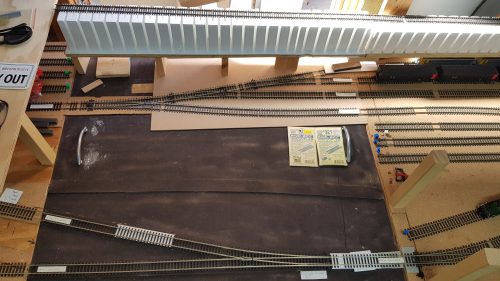 Image 4: This is Ivanhoe, SD, showing two industry sidings. Behind here is hidden storage for four BN/BNSF tracks plus another two tracks for continuous run and linking to another set of storage tracks on the other side. You can also see the second deck supports – wooden cross members and supports. The deck separation here is eight inches (200mm). The location above the storage sidings will be Wabasso, MN. Because I am relying on an incline to get to the upper deck and didn’t have a lot of available space for alternatives, I chose to minimise the height between decks but step out the scenic portion of the layout and use the space underneath the upper deck for staging. You can see how Ivanhoe is “stepped out” from the staging tracks and upper deck. I saw this method many years ago on a couple of layouts in Adelaide, South Australia, and operations were not compromised by having this benchwork arrangement.
Image 4: This is Ivanhoe, SD, showing two industry sidings. Behind here is hidden storage for four BN/BNSF tracks plus another two tracks for continuous run and linking to another set of storage tracks on the other side. You can also see the second deck supports – wooden cross members and supports. The deck separation here is eight inches (200mm). The location above the storage sidings will be Wabasso, MN. Because I am relying on an incline to get to the upper deck and didn’t have a lot of available space for alternatives, I chose to minimise the height between decks but step out the scenic portion of the layout and use the space underneath the upper deck for staging. You can see how Ivanhoe is “stepped out” from the staging tracks and upper deck. I saw this method many years ago on a couple of layouts in Adelaide, South Australia, and operations were not compromised by having this benchwork arrangement.
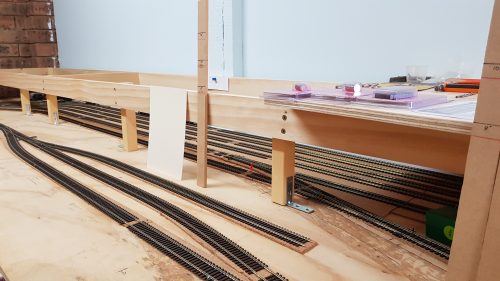 Image 5: The rear end of the garage showing the curve between Ivanhoe, SD, on the right (west) and Ronald, MN on the left (east). Whilst Ivanhoe is a real location, Ronald is made up and named after my father. My big mistake from this shot is not having insulated and gyprocked (wallboarded) the brick garage wall at his end.
Image 5: The rear end of the garage showing the curve between Ivanhoe, SD, on the right (west) and Ronald, MN on the left (east). Whilst Ivanhoe is a real location, Ronald is made up and named after my father. My big mistake from this shot is not having insulated and gyprocked (wallboarded) the brick garage wall at his end.
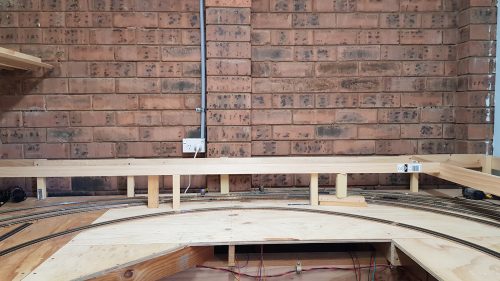 Image 6: Ronald is a significant town and has a number of industries for switching purposes. Being fictional, I have been able to add operational interest with a number of industries. The DME main line goes through the middle with sidings and spurs on either side. You can see the second deck supports – wooden uprights and cross-members. Initially, I used shelving brackets here but was not happy with them so went to my favoured wooden supports. The height here is still eight inches (200mm). The storage sidings to the right (and thus hidden staging) are for the BN/BNSF trains. In staging, there are four stub ended sidings on the right, a central through running track, and two double-ended sidings on the left (with the coal hoppers on one and the yellow Railbox car on the other). The blue underlay beneath the tracks in staging was originally a couple of yoga mats that I bought cheap from a two-dollar store (my wife would claim this was sacrilege!).
Image 6: Ronald is a significant town and has a number of industries for switching purposes. Being fictional, I have been able to add operational interest with a number of industries. The DME main line goes through the middle with sidings and spurs on either side. You can see the second deck supports – wooden uprights and cross-members. Initially, I used shelving brackets here but was not happy with them so went to my favoured wooden supports. The height here is still eight inches (200mm). The storage sidings to the right (and thus hidden staging) are for the BN/BNSF trains. In staging, there are four stub ended sidings on the right, a central through running track, and two double-ended sidings on the left (with the coal hoppers on one and the yellow Railbox car on the other). The blue underlay beneath the tracks in staging was originally a couple of yoga mats that I bought cheap from a two-dollar store (my wife would claim this was sacrilege!).
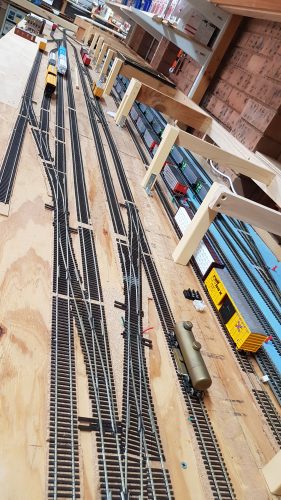 Image 7: The end of the peninsula. On the right you can see the diamond where the BN/BNSF trains come out of hidden staging and cross over the DME main line. The lower deck curve has the BN/BNSF on the outside rails and the DME is on the inside. On the upper deck, which will be hidden on the curve by a scenic board, the layout rises another two inches for the remainder of the route to Sleepy Eye. Inside the curve will be the dispatcher. The track curvature here is 36 inches.
Image 7: The end of the peninsula. On the right you can see the diamond where the BN/BNSF trains come out of hidden staging and cross over the DME main line. The lower deck curve has the BN/BNSF on the outside rails and the DME is on the inside. On the upper deck, which will be hidden on the curve by a scenic board, the layout rises another two inches for the remainder of the route to Sleepy Eye. Inside the curve will be the dispatcher. The track curvature here is 36 inches.
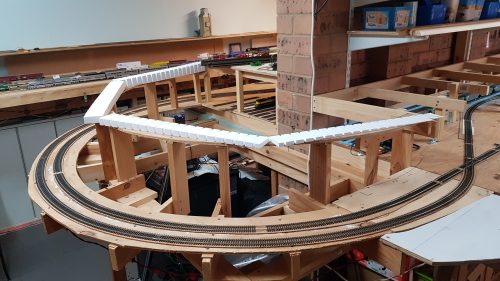 Image 8: Having rounded the central peninsula to the other side of the central brick wall, is the entrance to Marshall, MN, the biggest town on the layout. The BN loco is on the BN track and the DME locos are on the DME main line. The siding out front on the left is the program track and will have a propane industry. On the right will be Midwest Railcar Repair and further along another industry. The storage sidings behind are threefold: two tracks for a Twin Cities and Western (TC&W) operation, two tracks for storage of “one off” trains like the DME business car train and a steam tour train, and the fifth track is a yard lead. Above these storage tracks will be the main scenic highlight of the layout – a steel girder bridge crossing a floodplain between the location of Clement and Evan. Prototypically, the floodplain and bridge here are purely fictional. You can see that although the second deck here should be at 10 inches, it is lower and this is to allow for the bridge.
Image 8: Having rounded the central peninsula to the other side of the central brick wall, is the entrance to Marshall, MN, the biggest town on the layout. The BN loco is on the BN track and the DME locos are on the DME main line. The siding out front on the left is the program track and will have a propane industry. On the right will be Midwest Railcar Repair and further along another industry. The storage sidings behind are threefold: two tracks for a Twin Cities and Western (TC&W) operation, two tracks for storage of “one off” trains like the DME business car train and a steam tour train, and the fifth track is a yard lead. Above these storage tracks will be the main scenic highlight of the layout – a steel girder bridge crossing a floodplain between the location of Clement and Evan. Prototypically, the floodplain and bridge here are purely fictional. You can see that although the second deck here should be at 10 inches, it is lower and this is to allow for the bridge.
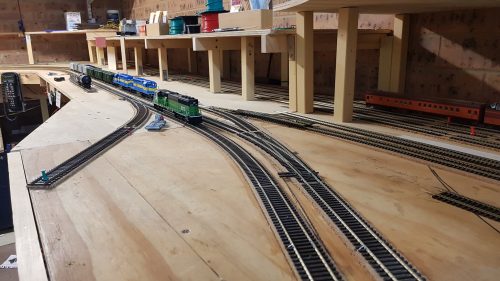 Image 9: This is the curve between Marshall and, well, Marshall (lower deck). Around to the left we continue into another set of tracks in Marshall with more industries and sidings to make up trains. On the upper deck is a narrow link between the bridge scene and Evan, MN. The risers here are testing to see if I need more height for the bridge scene. Again, not putting in insulation and wallboard here at this end of the garage was a mistake.
Image 9: This is the curve between Marshall and, well, Marshall (lower deck). Around to the left we continue into another set of tracks in Marshall with more industries and sidings to make up trains. On the upper deck is a narrow link between the bridge scene and Evan, MN. The risers here are testing to see if I need more height for the bridge scene. Again, not putting in insulation and wallboard here at this end of the garage was a mistake.
 Image 10: Marshall again, from the garage door end. The curve seen in the previous image is at the top right of this photo. The DME main line is immediately to left of the string of LMX locos. The empty track on the right of the LMX locos is the BN/BNSF main line. TC&W trains also enter here at Marshall (top left of photo) and weave onto the DME main line for the trip to Redwood Falls. The DME loco depot is just out of shot bottom left corner. Just outside of Marshall (beyond the bottom of this photo), there is the incline to the upper deck and also a branch line to Lake Marshall. The BN/BNSF continues around the bottom deck at right while the DME main line will swing around and start the two per cent incline to connect to the upper deck at Wabasso eight inches higher.
Image 10: Marshall again, from the garage door end. The curve seen in the previous image is at the top right of this photo. The DME main line is immediately to left of the string of LMX locos. The empty track on the right of the LMX locos is the BN/BNSF main line. TC&W trains also enter here at Marshall (top left of photo) and weave onto the DME main line for the trip to Redwood Falls. The DME loco depot is just out of shot bottom left corner. Just outside of Marshall (beyond the bottom of this photo), there is the incline to the upper deck and also a branch line to Lake Marshall. The BN/BNSF continues around the bottom deck at right while the DME main line will swing around and start the two per cent incline to connect to the upper deck at Wabasso eight inches higher.
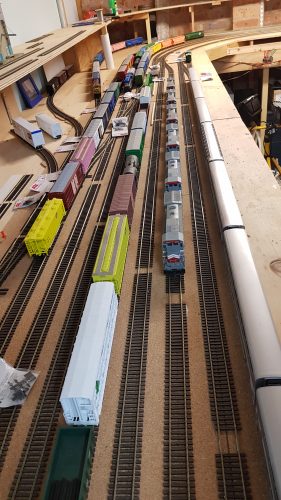 Image 11: Ths is the DME loco depot (the BN loco is an interloper and the Rock Island GP9 is waiting for a replacement DME GP9 body). You can see the second deck along this side of the garage uses metal angle brackets screwed into the wall timbers. I am experimenting with how to hide the brackets with a scenic board. I was smart enough to insulate and wallboard this western side of the garage (as the afternoon sun in summer is very hot).
Image 11: Ths is the DME loco depot (the BN loco is an interloper and the Rock Island GP9 is waiting for a replacement DME GP9 body). You can see the second deck along this side of the garage uses metal angle brackets screwed into the wall timbers. I am experimenting with how to hide the brackets with a scenic board. I was smart enough to insulate and wallboard this western side of the garage (as the afternoon sun in summer is very hot).
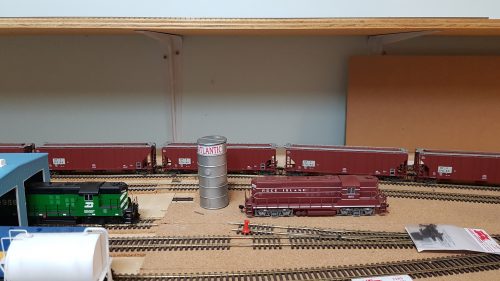 Images 12a and 12b: The photos are taken from outside looking into the garage from the garage door side of the building. You can see my peferred timber arrangement for holding up the second deck baseboard – Piersen is above us here. The fictional town of Piersen is named in memory of Joe Piersen of the Chicago and Northwestern Historical Society (CNWHS) who helped find information for me in the early development of the layout. The incline is on the right and the track just to the left of the incline goes to Lake Marshall and also allows DME trains continuous run on the bottom deck. The DME grain hoppers are on one of the three DME stub-ended hidden storage tracks.
Images 12a and 12b: The photos are taken from outside looking into the garage from the garage door side of the building. You can see my peferred timber arrangement for holding up the second deck baseboard – Piersen is above us here. The fictional town of Piersen is named in memory of Joe Piersen of the Chicago and Northwestern Historical Society (CNWHS) who helped find information for me in the early development of the layout. The incline is on the right and the track just to the left of the incline goes to Lake Marshall and also allows DME trains continuous run on the bottom deck. The DME grain hoppers are on one of the three DME stub-ended hidden storage tracks.

 Images 13a and 13b: These views are at the same location but taken inside the garage looking out. This area is the ADM facility in Marshall, MN, serviced by the BN/BNSF. The train with the freight cars out front is on the BN/BNSF passing track while in the distance is a pair of Wisconsin Central diesels heading towards Marshall on the BN/BNSF main line. You can see the upper deck and all the bits and pieces moved recently from all over the bottom deck to a new (temporary) resting place.
Images 13a and 13b: These views are at the same location but taken inside the garage looking out. This area is the ADM facility in Marshall, MN, serviced by the BN/BNSF. The train with the freight cars out front is on the BN/BNSF passing track while in the distance is a pair of Wisconsin Central diesels heading towards Marshall on the BN/BNSF main line. You can see the upper deck and all the bits and pieces moved recently from all over the bottom deck to a new (temporary) resting place.

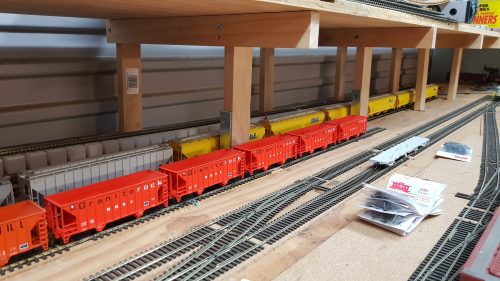 In image 13b (above), the Granite Rock ballast hoppers are on the inner edge of hidden staging here. This train will be a Dakota and Iowa Railroad (DAIR) train. Just over two inches lies between hidden staging and what will be the scenic board and the ADM facility (flats and photos) in front of it.
In image 13b (above), the Granite Rock ballast hoppers are on the inner edge of hidden staging here. This train will be a Dakota and Iowa Railroad (DAIR) train. Just over two inches lies between hidden staging and what will be the scenic board and the ADM facility (flats and photos) in front of it.
Image 14: Still on the lower deck, at the opposite side to where the previous photos were taken, we see the progression of the incline and the DME storage sidings back at Brookings. You can see the turnout on the right with the switch motor and wires which routes trains to Lake Marshall. Two sets of Woodland Scenics two per cent foam inclines have been used to make the eight inches necessary to reach the upper deck. The five stub-ended tracks in the foreground are DME staging representing Brookings, SD.
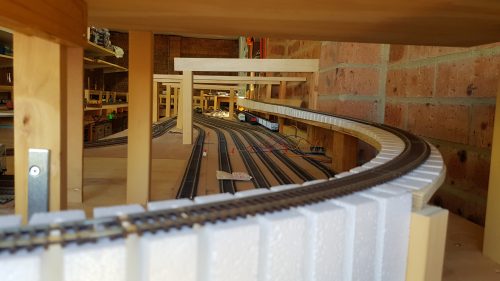 In conclusion, I hope these images are sufficient to show how the bottom deck of the layout falls into place, both in terms of the trackwork and construction. There is still much to do of course, but the journey is just as important as the destination….isn’t that right?
In conclusion, I hope these images are sufficient to show how the bottom deck of the layout falls into place, both in terms of the trackwork and construction. There is still much to do of course, but the journey is just as important as the destination….isn’t that right?

